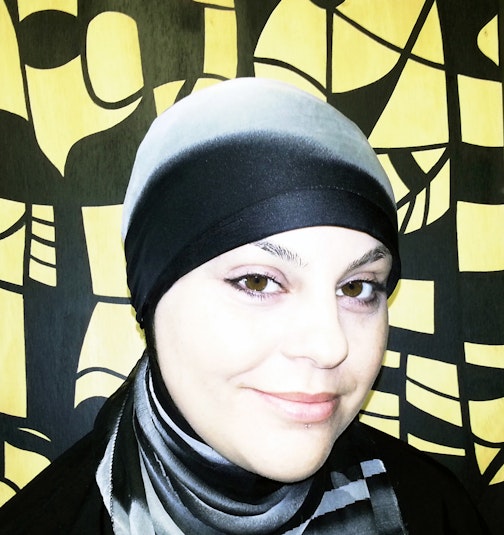This is how we do it: museums and galleries in Asia
Nur Shkembi
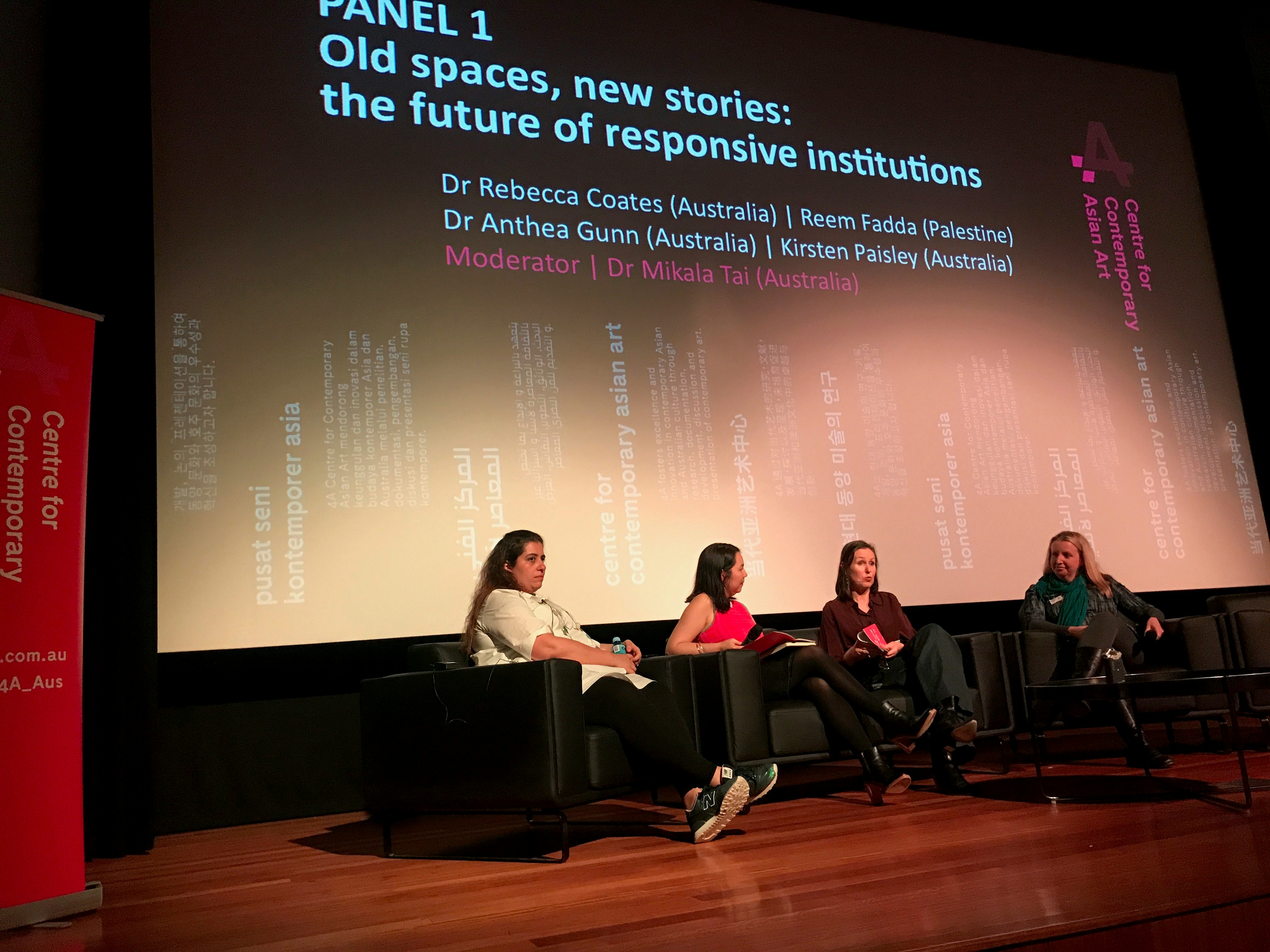
Panellists (from left to right): Reem Fadda, Mikala Tai, Rebecca Coates, Anthea Gunn. This Is How We do It: Museums and Galleries in Asia symposium, Victorian College of the Arts, Melbourne, 3 August 2018; photo: 4A Centre for Contemporary Asian Art.
‘… it is a commitment to see the history of art in conjunction with the history of humanity—a proposition that is humble, self-evident and audacious.’
— Geeta Kapur (1)
Future forward and no apologies. The introduction.
The desire for new histories alongside the ever-shifting geo-political landscape of the twenty-first century is playing an increasingly important role in the way in which we view ourselves within the global cultural landscape. In the most recent iteration of 4A Centre for Contemporary Asian Art’s annual symposium, This Is How We Do It: Museums and Galleries in Asia, 4A’s Director Mikala Tai and her team continued the essential work of offering multiple entry points for engagement with Asia. This included challenging the role of the traditional museum as an institution that must remain within the confines of a Eurocentric art historical frame. This notion is now being confronted with a new vision, one that immerses Australia in the Asia Pacific and beyond into West Asia. To be able to both examine and enter in to this new vision, Tai presented us with a looking glass; not one that is simply directed at Asia as expected, but rather, one that is pointing more urgently at ourselves.
It is time to reconsider Australia within a new geography, firstly as an uninvited colonial project forcibly transposed onto multiple Indigenous nations and, secondly, as a country that is geographically removed from the belly of the white centre in Europe. In a radically remapped world we can begin to see local culture as an entity that is able to be subsumed into other cultural realities beyond America and Europe; a new cultural landscape that positions Asia at our heart, rather than our hearth, inviting us to reimagine our cultural institutions. Enough gazing into Asia like a distant, exotic spectacle that is disconnected from our contemporary reality, and welcome to the essential work towards a cosmopolitan future.
Let’s get cracking. The business of opening the symposium and a few other directorial delights.
In their opening remarks, Tai described how the symposium brought together ‘leading professionals from museums and galleries across wider Asia to share experiences and discuss what’s next for our region’s cultural and creative spaces.’ The symposium, held at VCA’s Federation Hall in Melbourne, was officially opened by Pro Vice-Chancellor Engagement and Director, Centre of Visual Arts (COVA), Victorian College of the Arts, Professor Su Baker. In her opening address, Baker acknowledged First Nations people and the national agenda of COVA as ‘one of truth telling and one of a commitment to reconciliation.’ Baker also spoke of further potential collaborations between COVA and 4A, which conferred a sense of a symposium with a potential enduring legacy.
Tai began with a recollection of the historical connections that exists between Australia and Asia through the enterprise of fishing and trade. This contact between the Makassan fisherman from Indonesia who travelled south to fish the sea cucumber with First Nations people, in fact, pre-dates white settlement and records show contact dating back as early as the sixteenth-century. Tai referred to the waters that separate this land mass (of what is known today as Australia), from the rest of Asia as being ‘waters that not divide … but connect.’ Her opening perspective sought to underpin the symposium with the intimation of the possibilities that reimagining the geography of our region can bring.
Nothing new to see here. Changing global contemporary art concepts.
As a precursor to the presentations by local and international guest speakers, Professor Charles Green of the University of Melbourne discussed some key issues and undercurrents including the critical role of biennales, triennials and documenta, as being the exhibitions that essentially formulated what we know as contemporary art. Green also suggested that the present prominence of private art foundations and museums signals that they may now be leading the way; it may no longer be public sector institutions that are necessary fuelling the innovations in contemporary art, curatorship and museums. Along with that, the Eurocentric model is no longer the central premise for the way cultural institutions engage and collect. Green went on to state, ‘art history taught still at Harvard and the story shown at MoMA, still was and is wrong. Full-stop. Wrong. The great art museums are not coping well with these changes.’ In consideration of the globalisation of the arts, Green also put forth the issue of appropriation: ‘We are all intensely aware of the huge complex controversies surrounding speaking positions and cultural appropriation.’ There is an overwhelming feeling that we are on the precipice of major change and Green reaffirms what many of us are seeing, that great art is made all around the globe, and always has been.
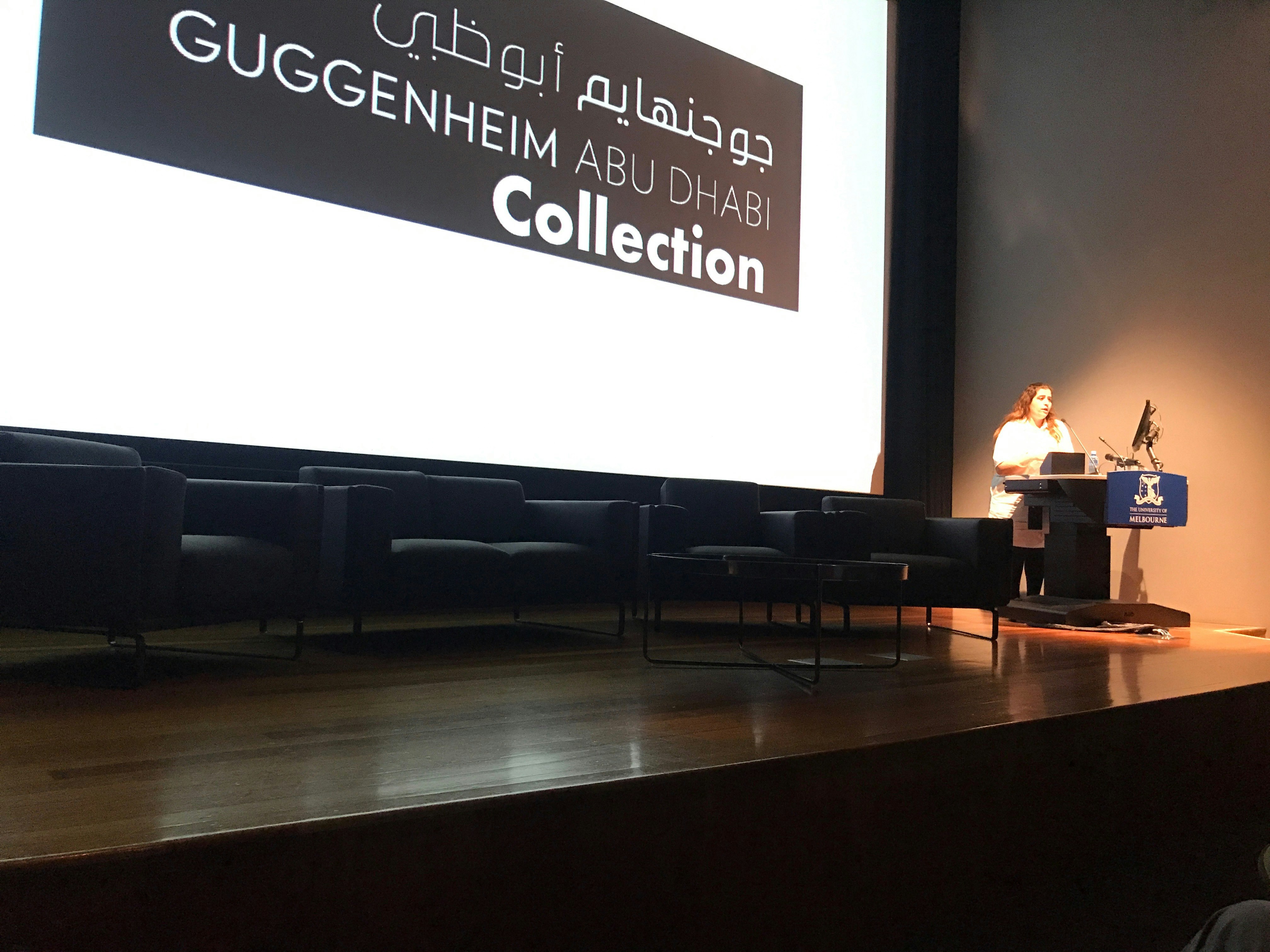
Reem Fadda focus presentation, This Is How We Do It: Museums and Galleries in Asia symposium, Victorian College of the Arts, Melbourne, 3 August 2018; photo: 4A Centre for Contemporary Asian Art.
The GPS is broken … Oh, and by the way, where is the Middle East again? Radical geographies: on curating a collection outside a collection and into a new consciousness.
In this focus session, independent Palestinian curator Reem Fadda put forward the grand challenge of the twenty-first century museum: rectifying the untold histories, that being the amnesia and erasure of history. Fadda immersed the audience into her practice and drew upon her experiences to introduce some of the radical rethinking our institutions must consider to be able to recalibrate the museum as a democratised and cosmopolitan space. She proved an extraordinary orator—with great precision Fadda tendered her thoughts on numerous pressing issues, including the importance of challenging the geography with which many cultural institutions classify their collections. In her eight-year tenure at the helm of Middle Eastern Art at the Guggenheim Abu Dhabi, Fadda focused on the collection of what was originally tenured as the Middle Eastern Collection.
The first challenge Fadda undertook as curator of ‘Middle Eastern’ art, was to reclassify the region and decolonise the associated language. This was for her a long, rigorous but necessary process and it was on the advice of highly regarded Indian art historian Geeta Kapur that Fadda pushed forward within the institution, reclassifying and renaming the ‘Middle East’ as West Asia. By positioning Asia as the central geographical point of reference and by addressing history through a decolonised geography, Fadda applied a critical methodology that has created space for a cultural shift. This methodology later informed further critical alterations in the historisation of art and the pressing questions of Modernism and contemporaneity. By altering the language and renovating the parameters to encompass West Asian artists from the 1960s in her definition of contemporary art, Fadda embarked upon the magnificent journey of rectifying the ‘gap’ in art history. This monumental action addressed a Eurocentric art historical mainstay that basically positioned Asia as ‘lagging behind’ the West. Fadda further engendered this idea with a strong statement of purpose, one that positioned West Asian artists beyond geography as being different by stating, ‘They are not creating form for the sake of form.’ What we see today of contemporary art is a practice that is socially and politically engaged and Fadda suggests that if we traced this practice back to its roots, we would land in the global south, decades prior to the claim of contemporary art in the West.
Not New NOW.
Fadda also spoke of her experience as Curator of the 2016 Marrakech Biennale as a critical time that allowed her to deconstruct core themes relating to time and to consider the question, why not new? According to Fadda, it was a philosophical treatise to think about newness and cultural newness and their connections to form and the notions of the ‘modern’. What Fadda uncovered in Morocco related to her broader findings in relation to the historicisation of art in the confines of both personal and socially sanctioned understandings of time. There was a stark difference between her experiences in Morocco and New York where she studied, lived and worked for a time. In Morocco, Fadda realised she owned her own time: ‘So I was in the now in Morocco … what does that mean? It meant modernity for me … this is what defines the modern figure, he who owns time.’ She elaborated this as not one who owns wealth nor who can accumulate wealth, but it is the one who owns time: ‘… that was a defining moment I realised in our inherited definitions of modernity; what we have is a race towards newness and a race towards the accumulation of wealth, there is that legacy of colonialism. Everything that is big and massive … and there is a manifestation of accumulation of wealth.’ This in turn deepened her research into the cultural practitioners who have owned their time. The correlation between the cultural understandings about time and space (geography) in the East and West, is a critical tool in discerning contemporary art as living art; ‘it is about the people, the emphasis is on the person,’ and thereby confirming her resolve in the classification of the West Asian art collection.
With that, Fadda asked her audience, ‘How do we rectify the untold histories, the erasure, the amnesia we see in a lot of western institutions and even institutions up to here in Australia. What have we inherited and what are we taking for granted and how are we aware of creating new mechanisms … that enables a new and vibrant discourse that really represents the world?’
Ground control to Major Tom. The odyssey of the responsive institution.
In the symposium’s first panel discussion, titled Old spaces, new stories: the future of responsive institutions, the assembled speakers reflected on regional, local and global visions, in both the uniqueness and differences. The broad sentiment of the discussion was summed up early in the conversation by Rebecca Coates, Director of Shepparton Art Museum in regional Victoria, as ‘rewriting histories and moving forward.’ As moderator of the conversation, Mikala Tai offered a provocation concerning the self-awareness of curating through history and suggested that the curator does not laden the artist with the role of history. Reem Fadda responded to this by stating there are ‘two moments that are unchangeable: history and art,’ and with that suggested there is a type of witness by the artist that is a ‘charged potential we can’t do away with.’ In this sense, the artist understands material history with the complexities of time, space and materiality and the basic premise that art and history are simultaneous. The overwhelming issue, however, is the concern with the ‘whiteness’ of institutions and to this end Tai further posed the question of challenging structures and not just stories.
Joined by Anthea Gunn, Senior Curator of Art at the Australian War Memorial, the panel’s speakers each generated conversation from their local position, which is of course, also within the global context. Coates provided some basic but very important advice regarding good institutional practice, suggesting that it requires engagement across various platforms and the courage to engage artists, always outstanding, who may or may not be well known, but who can potentially connect with the audiences. Gunn added an important element to the discussion by centralising the audience experience in the considerations of how institutions need to respond, referring to the visitation data at the War Memorial that suggests that audiences visit with intent.
The future is female… and this is how WE do it! The future of the museum has arrived: feminism as a tool in reimagining a collection.
Joselina Cruz, Director of Manila’s Museum of Contemporary Art & Design (MCAD), began her focus presentation with two moments that touch upon curatorial practice—seeing and engaging with space. Cruz located her curatorial rationale within an understanding of the ‘fragmented global’ and of spoke of the importance of what ‘challenges our ability to think about how localities across the globe and how they continually reinvent and engage the larger global narrative in a continual flow of negotiation … to jump across and cross both temporal and historical fences.’
Cruz presented three fascinating case studies that illuminated this contention further, however, it was her discussion of Pacita Abad: A Million Things to Say, a major solo exhibition of work by the late Filipino artist (1946–2004) that was presented at MCAD earlier this year and was co-curated by Cruz and the artist’s nephew Pio Abad, that revealed a compelling methodological approach of a museum exhibition. Cruz noted that for Abad, being female, a woman of colour and possessing an assertive and vibrant persona often created tension within the Manila art community especially and, as a result, Abad and others felt that during her lifetime she not taken seriously as an artist within the Philippines. Given this, Cruz expanded on how she felt Abad’s work required re-evaluation, especially in order to create a space for appraisal and criticality that is beyond the self-orientalisation the artist was commonly pigeonholed as engaging in. As Crux explained, this enterprise was a huge undertaking. Abad produced over 5,000 works including a series of masks inspired by African forms. Cruz spoke to the masks in particular to point out that this was a type of appropriation; however, she noted that Africa has historically been appropriated by white culture, so this in many ways is a curious thing to consider as a woman of colour.
According to Cruz, Abad is part of an historical moment in the Philippines, responding to local political trauma ‘by creating paintings about events taking place elsewhere.’ Abad painted the lives of refugees and displaced people, and Cruz described her as being ‘affected by their plight but separate from their fate and destiny. The ease of her diasporic existence was her estrangement from theirs, again the personal is highly political.’ It is within this reimagining of the curatorial framework that Cruz cut through the historical, to present the complexity of global culture in the local, through the work of Abad as a contemporary experience. Cruz centred the female figure as her curatorial methodology and the result that produced speaks to the enormity of the challenges faced by women, not only in the Philippines but at a global level.
Cruz’s work with the Pacita Abad exhibition can perhaps be best understood through curatorial theorist Elke Krasny’s use of feminist curatorial methodologies, wherein the application of binaries and dichotomies are part of the ‘politics of location’ (2). What Cruz was in fact touching on in the presentation of Abad’s work was the broader issue of what Krasny suggests about the binaries we often refer to in seeking the gaps, always to find that power is either afforded to one side or the other. Through her curatorial practice, Cruz ultimately reveals a narrative that underscores the multitudes of ways we experience imbalances in power, and with that invoked a subversive critical commentary on global issues.
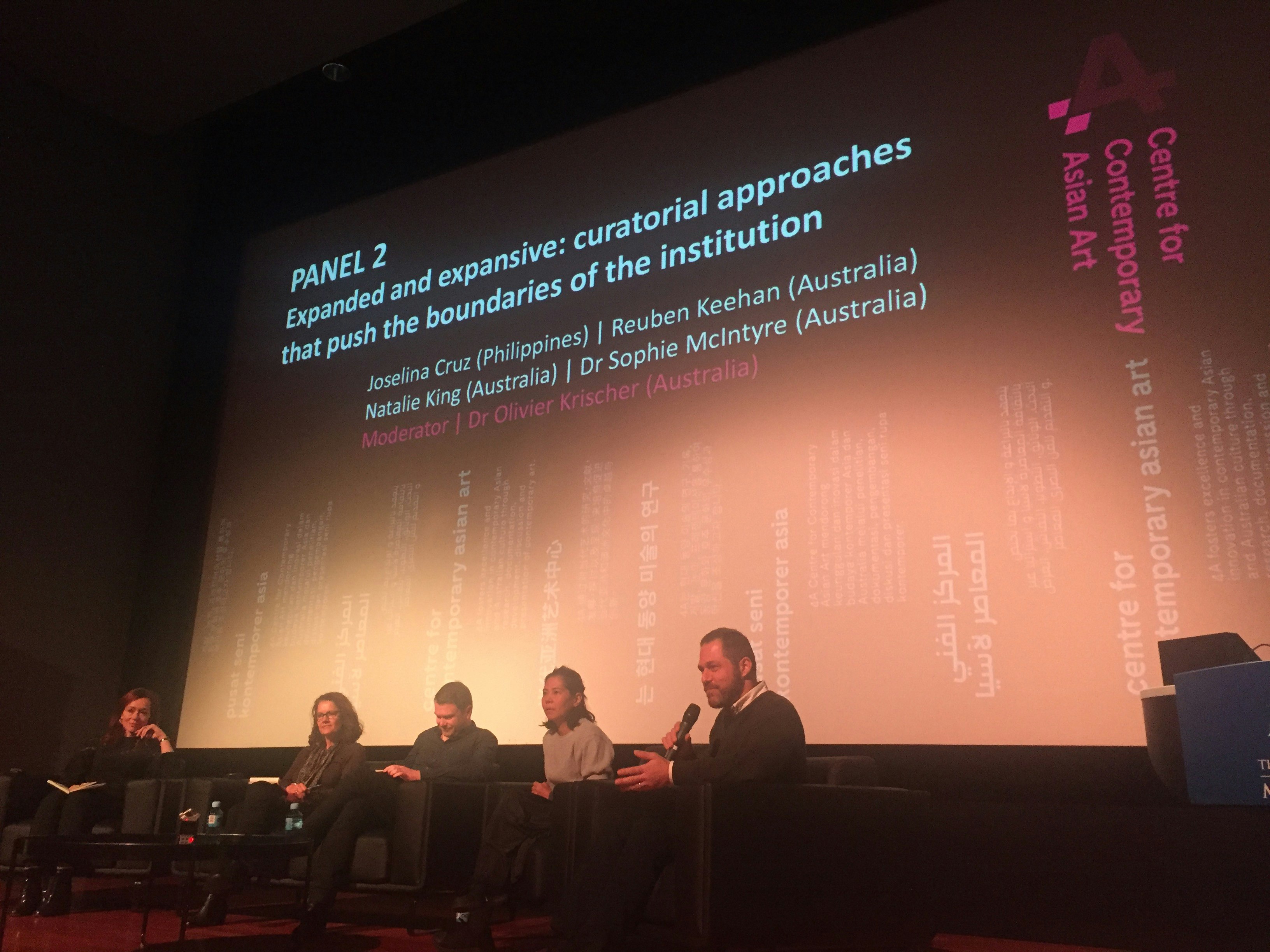
Panellists (from left to right): Natalie King, Sophie McIntyre, Reuben Keehan, Joselina Cruz and Olivier Krischer. This is How We Do It: Museums and Galleries in Asia symposium, Victorian College of the Arts, Melbourne, 3 August 2018; photo: 4A Centre for Contemporary Asian Art.
The curatorial crunch and boundary busting practice. That ain’t no dance move. We’re talking about curator talk.
Olivier Krischer, Deputy Director of the University of Sydney’s China Studies Centre and a seasoned art researcher and writer, opened the symposium’s second panel discussion with a remark relating to the shift in the curatorial approach of Brisbane’s Asia Pacific Triennial of Contemporary Art (APT) back to an institution-based model and the growth of the Pacific art representation. The temptation of a Western art museum is to give in to the influence of the art market in terms of the art historical narrative and, he suggested, ‘going beyond the institutional boundaries.’ Panellist Joselina Cruz mentioned that the APT was one of the first Australian initiatives to engage with the Philippines and relayed that its organiser, the Queensland Art Gallery, had people on the ground for many years, looking towards Asia as something to understand. The APT came in with a very different model to the Singapore Art Museum who had begun collecting the ‘entire history of South East Asia’ and, once again, that notion of biennales and triennials providing a very particular context for artists. Cruz stated that ‘as curators we have to be able to go beyond what we have and delve deep into the histories, not just at the face value… and insisting on having critical moments.’
As independent curators, Natalie King and Sophie McIntyre move between institutions and therefore brought to the panel discussion, titled Expanded and expansive: curatorial approaches that push the boundaries of the institution, a multiplicity of perspectives on the varying missions and challenges faced by curators working within institutions. McIntyre described this as a ‘learning process’ and, referring back to Reem Fadda’s presentation she stated, ‘my time has been my own time as an independent curator with the agility’ and ‘ability to adapt’ across boundaries as a core skill. King spoke of working across multiple modes and a range of activities and stated that she always likes to return to the idea of interconnectivity: ‘I am interested in the linkages between objects, people, a place, history and discourses and I am always thinking through these particular ideas when I am working in different formats.’ For King, the notion of the gate keeper in the arts is more about having an ‘open door’ and being hospitable to new ideas.
Krischer then returned to Cruz’s comment about ‘the fragmented globe’ as a space that is global but also fragmented either of our histories, prompting the question about how we weave those fragmented histories, asking ‘How do you curate between the fragments?’ For Cruz, working across areas of the local, regional or global is essential, ‘establishing ways of looking and seeing across art languages.’
Reuban Keehan, Curator of Asian Art at Queensland Art Gallery / Gallery of Modern Art (QAGOMA) and a key figure of the team that formulates recent iterations of the APT, responded to the notion of the ‘fragmented globe’ by referring to the early APT’s pioneering work in shifting ‘the emphasis away from this Eurocentric history to a much more polyvocal one.’ He proposed this within the reality of Brisbane which has ‘rich, diverse and longstanding Asian and Pacific cultures and people living within it.’ At the level of representation within a cultural institution, the APT was ‘actually enabling agency for those communities [which] means going much further; and I think we have real problem, there is a real diversity problem in the Australian art world structurally and institutionally … there are not enough communities represented on staff and on boards within institutions … there is a lot more work to do in that area … so I think especially be an activist within your own institution,’ he stated. Keehan further suggested applying a curatorial perspective ‘where you can to encourage the creation of new solidarities between these fragment is something that we can do within the space of an exhibition … I have been interested not just in the meta discourse of biennales and triennials … but in the community of artist they have brought together.’
Nearing the conclusion of the discussion, McIntyre spoke of ‘an exhibition being a fragment in itself.’ However, she went on to suggest that each exhibition is like ‘adding to the narrative … each exhibition is like a block.’ Responding to the idea of ‘excavating the fragment,’ King suggested ‘it is important as curators, researchers or scholars that we listen to hidden murmurings’ and that there is important work to be done ‘revisiting histories, and excavating hidden, forgotten, lost and overlooked histories.’ It is important that we do so within the knowledge, as King states, ‘that artists have an immense capacity to interrogate histories.’
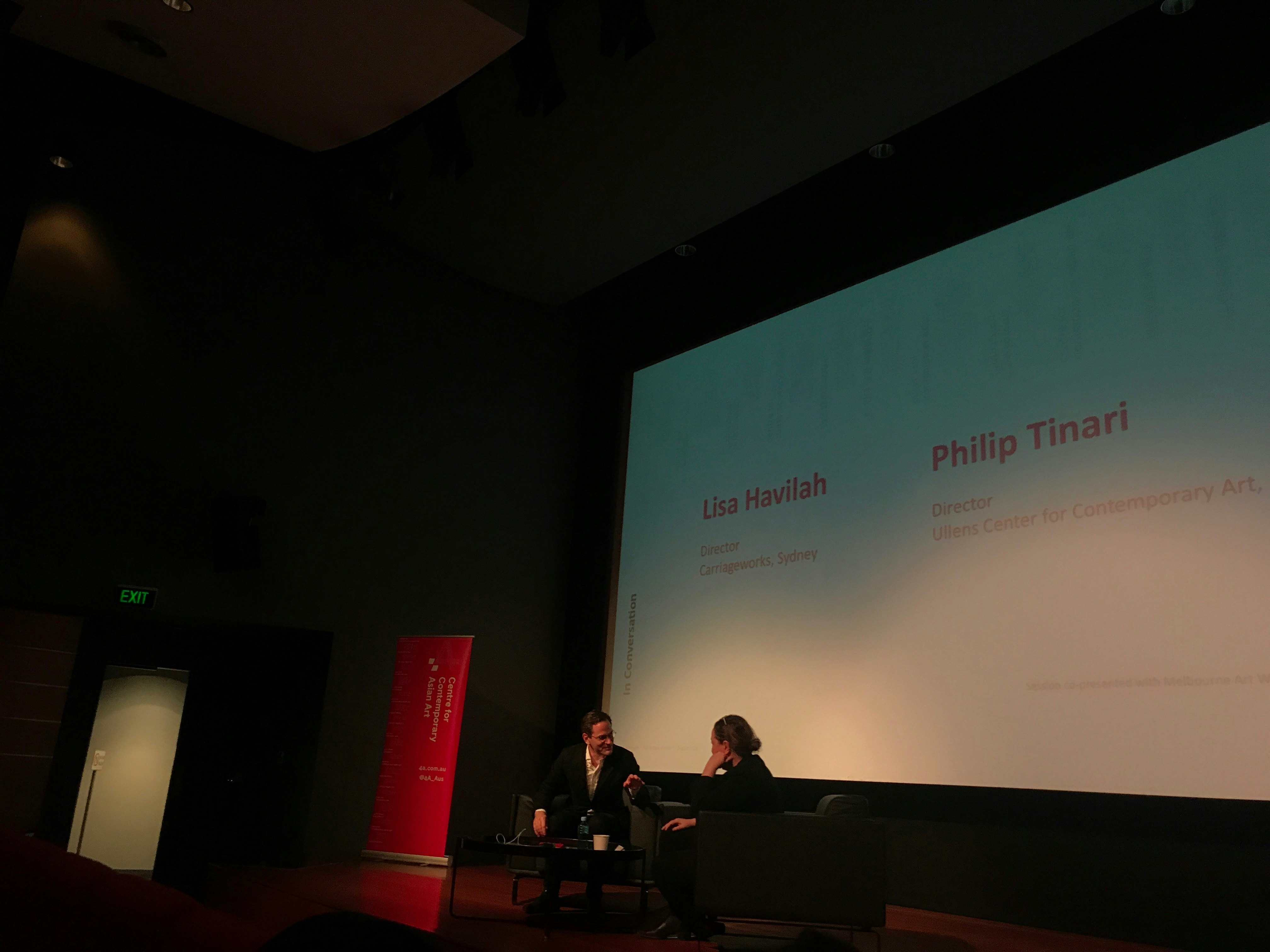
Philip Tinari and Lisa Havilah, This Is How We Do It: Museums and Galleries in Asia symposium, Victorian College of the Arts, Melbourne, 3 August 2018; photo: 4A Centre for Contemporary Asian Art.
Public Enemy? Don’t believe the hype. Private museums and public institutions.
In the day’s final session, which was presented in conjunction with the Melbourne Art Fair, Lisa Havilah and Philip Tinari were invited by Mikala Tai to unpack ‘how commercial ideas and creative ideas can sit together in a complementary manner.’ Havilah, Director of Carriageworks, opened by prompting Tinari to speak about the recent transition of the Ullens Center for Contemporary Art (UCCA) in Beijing, of which he is Director, from a private museum to a public foundation, quoting back to Tinari his description of this experience as ‘a year of uncomfortable uncertainty.’ According to Tinari, the process of transition involves the notion of a ‘private idea that is becoming more and more publicly minded,’ and of looking at something bigger than just ‘Ullens and his collection’ (referring to Guy Ullens, the Belgian-born businessman and collector who established UCCA).
As the conversation developed, Tinari summarised a crucial descriptor of what it means to be public, suggesting there are different ways to be public, it’s not just about legal and governance structures, ‘… but also the persona and the sort of heart and soul of an institution and whom it exists to serve.’ He highlighted that an important element of UCCA is children’s education, where there is a deliberated component in what the Center does through art to ‘teach independent thinking and creativity.’ Tinari extended this comment by stating that UCCA are ‘teaching creative thinking to people at the very beginning of the life cycle in a way that will ultimately probably bring people back to this larger community of reception around art and culture.’
Tinari spoke specifically to Xu Bing: Thought and Method, a retrospective that at the time of this symposium was concurrently on show at UCCA, as being the most successful show ever mounted at the Center in terms of visitor numbers. Xu Bing’s exhibition was described by Tinari as a ‘deeply serious show’ and Havilah queried if this is due to the value ascribed to its ‘cultural relevance’ and of audiences wanting to see themselves reflected in the art. Tinari suggested that ‘China is at a moment where it is has, I think, in a very short span … radically reassessed its position in, and relationship to the wider world, this comes down to individual and how they understand their subjectivity and agency in relation to these broader geopolitical and socio-economic transformation that is going on.’ Much of Tinari’s experiences and insights can be transferred beyond China where the critical issues he raised are prove pertinent to institutions globally. In his brief dialogue, he provided the audience a context in which to better consider education as one of the other key directions Chinese institutions are working towards, alongside community building that goes on around the institution.
The end is nigh. The final word.
‘We believe Asian cultural literacy is the future for contemporary art and cultural practice, making and experiences in Australia.’
— Mikala Tai.
This Is How We Do It: Museums and Galleries in Asia was co-presented by 4A Centre for Contemporary Asian Art and the University of Melbourne at Federation Hall, Victorian College of the Arts, 3 August 2018. Additional support was provided by partners Artspace, Sydney, and Melbourne Art Week.
Notes
(1) Geeta Kapur from a transcript of the keynote lecture ‘Recursive narrative: ways of producing art history’ held at Haus der Kunst, Münich, 14 October 2016. Published on the institution’s blog [accessed 19 October 2018].
(2) Elke Krasny, ‘Feminist thought and curating: on method,’ On Curating 26 (2015) [accessed 19 October 2018].
About the contributor
Nur Shkembi is a Melbourne-based curator, writer and PhD scholar undertaking interdisciplinary research in material conservation, curatorship and decolonial theory.
